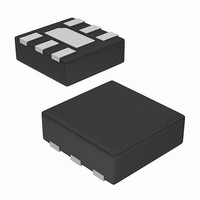ISL29003IROZ-T7 Intersil, ISL29003IROZ-T7 Datasheet - Page 10

ISL29003IROZ-T7
Manufacturer Part Number
ISL29003IROZ-T7
Description
IC SENSOR LIGHT-DGTL I2C 6-ODFN
Manufacturer
Intersil
Datasheet
1.ISL29003IROZ-EVALZ.pdf
(15 pages)
Specifications of ISL29003IROZ-T7
Wavelength
540nm
Output Type
I²C™
Package / Case
6-ODFN
Lead Free Status / RoHS Status
Lead free / RoHS Compliant
Other names
ISL29003IROZ-T7TR
Available stocks
Company
Part Number
Manufacturer
Quantity
Price
Company:
Part Number:
ISL29003IROZ-T7
Manufacturer:
INTERSIL
Quantity:
1 831
Solution 2
Using External Timing Mode
From Solution 1, the desired integration time is 100ms. Note
that the R
frequency when using external timing mode. Instead, the
integration time is the time between two sync_iic commands
sent through the I
many I
commands.
i
i
i
sent 1,000 cycles after another sync_iic command rejects
both 60Hz and 50Hz AC noise signals.
Next, is to pick an arbitrary R
Gain/Range Mode. For a maximum 500 lux, Range1 is
adequate. From Equation 3:
FSR
FSR
The effective transfer function becomes:
E
I
I
I
2
2
2
DESIGN PARAMETER
DESIGN PARAMETER
TABLE 14. SOLUTION1 SUMMARY TO EXAMPLE DESIGN
TABLE 15. SOLUTION2 SUMMARY TO EXAMPLE DESIGN
C
C
C
DATA is the sensor reading data located in data registers
04(hex) and 05(hex)
COUNTER is the timer counter value data located in data
registers 06(hex) and 07(hex). In this sample problem,
COUNTER = 1000.
=
Gain/Range Mode
Gain/Range Mode
Transfer Function
Transfer Function
= 1,000 I
= f
= 10kHz
# of clock cycles
# of clock cycles
------------------------------- -
COUNTER
=
=
2
I
2
DATA
1000 lux
1000 lux
C clock cycles to wait between two external timing
C*
R
R
FSR
EXT
FSR
t
t
EXT
t
EXT
int
int
int
PROBLEM
PROBLEM
2
*
100ms
C clock cycles. An external sync_iic command
= number of I
resistor only determines the inter oscillator
100kΩ
----------------- -
100kΩ
×
2
1000 lux
C. The programmer determines how
2
EXT
C clock cycles
10
E
=
E
= 100kΩ and to choose the
Range1 = 1000 lux
Range1 = 1000 lux
------------------------------- -
COUNTER
COUNTER = 1000
=
DATA
---------------- -
DATA
2
2000 lux
1000 lux
16
VALUE
VALUE
100ms
100ms
100kΩ
50kΩ
2
16
×
2000 lux
×
1000 lux
ISL29003
IR Rejection
Any filament type light source has a high presence of infrared
component invisible to the human eye. A white fluorescent
lamp, on the other hand has a low IR content. As a result,
output sensitivity may vary depending on the light source.
Maximum attenuation of IR can be achieved by properly
scaling the readings of Diode1 and Diode2. The user obtains
data reading from sensor Diode1 (D1), which is sensitive to
visible and IR, then reading from sensor Diode2 (D2), which is
mostly sensitive from IR. The graph in Figure 8 shows the
effective spectral response after applying Equation 19 of the
ISL29003 from 400nm to 1000nm. Equation 19 describes the
method of cancelling IR in internal timing mode.
Where:
data = lux amount in number of counts less IR presence
D1 = data reading of Diode1
D2 = data reading of Diode2
n = 1.85. This is a fudge factor to scale back the sensitivity
up to ensure Equation 4 is valid.
k = 7.5. This is a scaling factor for the IR sensitive Diode2.
Flat Window Lens Design
A window lens will surely limit the viewing angle of the
ISL29003. The window lens should be placed directly on top
of the device. The thickness of the lens should be kept at
minimum to minimize loss of power due to reflection and
also to minimize loss of loss due to absorption of energy in
the plastic material. A thickness of t = 1mm is recommended
for a window lens design. The bigger the diameter of the
window lens, the wider the viewing angle is of the ISL29003.
Table 16 shows the recommended dimensions of the optical
window to ensure both 35° and 45° viewing angle. These
dimensions are based on a window lens thickness of 1.0mm
and a refractive index of 1.59.
D3
WINDOW LENS
ISL29003
=
n D1 kD2
(
–
FIGURE 4. FLAT WINDOW LENS
)
D
LENS
∅
∅ = Viewing angle
D1
t
August 8, 2008
D
(EQ. 19)
TOTAL
FN7464.5












